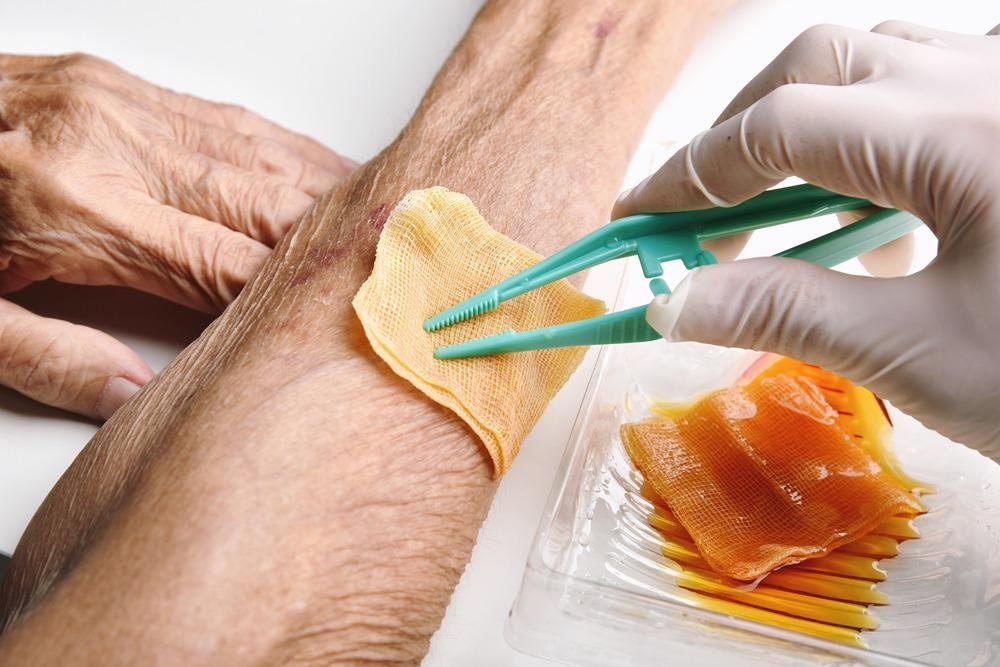Novel wound healing research has been published in the journal ACS Nano, which utilizes a self-bonded hydrogel to create a flexible patch.
Study: Self-Bonded Hydrogel Inverse Opal Particles as Sprayed Flexible Patch for Wound Healing. Image Credit: ARTFULLY PHOTOGRAPHER/Shutterstock.com
This innovative study aims to be used for wound tissue healing as well as potential drug delivery applications.
Wound Healing
With wounds being a part of everyday life, it is important to evaluate the level of healing of individuals. This can vary due to conditions that slow down healing, such as diabetes and can be categorized into acute and chronic wounds.
Acute wounds can take up to a number of months to heal; however, chronic wounds may extend to several years, with continued inflammation being a large issue.
Approximately 300,000 people are hospitalized per year in the United States for acute wounds and with an aging population, such as the number of people aged 65 and over, estimated to double by 2030, chronic wounds numbers may also increase exponentially, both due to diabetes and age-associated non-healing factors.
The wound process can be summarized into four phases:
- Hemostasis – this consists of the formation of the platelet plug and coagulation
- Inflammation – vasodilation occurs, and immune cells gather to prevent infection
- Proliferation – this leads to the formation of new granulation tissue
- Remodelling – this stage can cover months and even years, comprising scar formation, where the granulation tissue starts maturing
With this common process being a critical part of everyday life, it has gathered attention for biomedical science research in to enhance the healing ability of individuals.
This is especially important due to the process of wound healing being susceptible to factors that may reduce effective healing, including bacterial infections that can increase the risk of sepsis, granulation hyperplasia and even death.
Enhancing Wound Healing
Research into enhancing wound healing has encompassed various avenues, including drug-intervention therapy to reduce inflammation, broad-spectrum antibacterial drugs, growth factors to promote vascular remodeling, as well as a range of wound healing patches and dressings.
Existing wound patches have incorporated nanotechnology such as nanofibers, hydrocolloids and foam to directly close the wound to reduce infection and deliver drugs.
Hydrogels, in particular, had demonstrated efficacy for promoting wound healing with the use of hydrogel membranes and particles that aimed to provide moisture to the wound bed.
However, with limitations such as poor air permeability, structural instability, and an incapacity to respond to the external environment, hydrogel patches have been seen to lack versatility and require further development for clinical use.
The researchers of this paper aimed to solve and advance the current hydrogel dressings available, with self-bonded hydrogel inverse opal particles that can be used as a sprayed flexible patch for wounds.
This research included the use of inverse opal particles, which were reversely replicated from photonic crystal templates, and used ubiquitously for detection and drug release, due to their 3D interconnected micropores.
Incorporating inverse opal particles within hydrogels would increase its versatility, with responses to external environmental stimuli, including temperature-responsiveness, photo-responsiveness, and magnetic-responsiveness.
The inverse opal was used as scaffolds to infusion drug-loaded reversible phase-changing pregel, within the hydrogel particles.
The researchers produced scaffolds, which consisted of hyaluronic acid methacryloyl (HAMA) and gelatin methacryloyl (GelMA) with graphene oxide quantum dots (GO QDs) doping. Additionally, the pregel consisted of gelatin (GT) and carrageenan (CG) with amoxicillin and VEGFs encapsulations being added into the inverse opal scaffolds.
These hybrid particles were able to have high photothermal conversion capabilities due to the graphene oxide quantum dots as well as having temperature reversible phase-changing performance, attributed to the pregel combination of gelatin and carrageenan.
The pregel allowed the particles to go through a liquid transformation under near-infrared irradiation without the scaffold structure being destroyed, enabling the adjacent particles to adhere to each other, resulting in a flexible patch.
Clinical Implications
The clinical implication for this research is significant as with wound healing impacting almost every person worldwide at some point, this area of development is necessary.
A 2018 retrospective analysis of Medicare beneficiaries found that approximately 8.2 million people were affected by wounds, with or without infections. Additionally, the cost of treatment for acute and chronic wounds was estimated to be between $28.1 billion and $96.8 billion.
From acute wounds to non-healing wounds to surgical wounds and diabetic ulcers, this area of medicine is critical for advancements, which will allow patients to have a better quality of care as well as reduce the burden on healthcare systems.
Interestingly, with this research also being translatable for a controllable drug delivery system such as through encapsulating antibacterial antibiotics including amoxicillin and growth factors including VEGF, to increase the vascular remodeling process, its application for medicine and healthcare could be revolutionary.
Prioritizing patient care through tackling one of the major contributors to declining health may be an effective method to assist the aging population and increase well-being for all wound care patients.
Continue reading: NANO-LLPO: Using Nanomaterials to Heal Wounds.
Reference
Wang, L., Sun, L., Bian, F., Wang, Y. and Zhao, Y., (2022) Self-Bonded Hydrogel Inverse Opal Particles as Sprayed Flexible Patch for Wound Healing. ACS Nano,. Available at: https://pubs.acs.org/doi/full/10.1021/acsnano.1c09388
Further Reading
Demidova-Rice, T., Hamblin, M. and Herman, I., (2012) Acute and Impaired Wound Healing. Advances in Skin & Wound Care, 25(7), pp.304-314. Available at: https://doi.org/10.1097/01.ASW.0000416006.55218.d0
Sen, C., (2019) Human Wounds and Its Burden: An Updated Compendium of Estimates. Advances in Wound Care, 8(2), pp.39-48. Available at: https://doi.org/10.1089/wound.2019.0946
Disclaimer: The views expressed here are those of the author expressed in their private capacity and do not necessarily represent the views of AZoM.com Limited T/A AZoNetwork the owner and operator of this website. This disclaimer forms part of the Terms and conditions of use of this website.